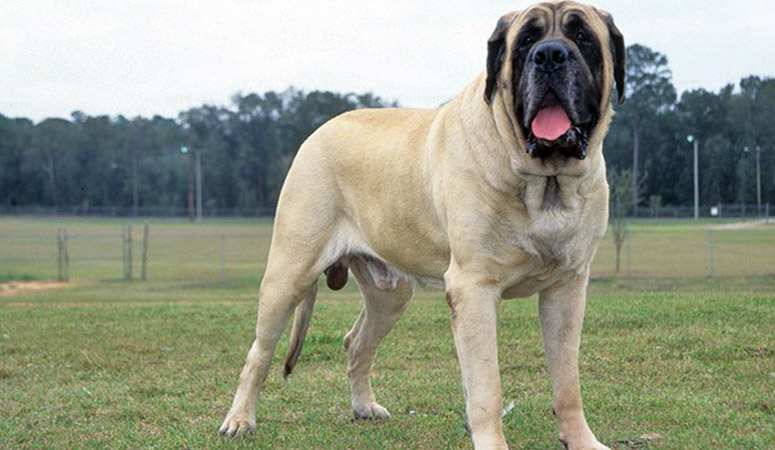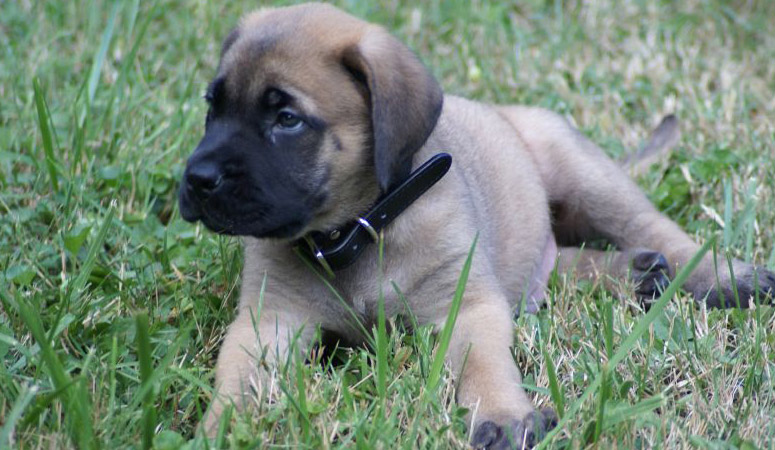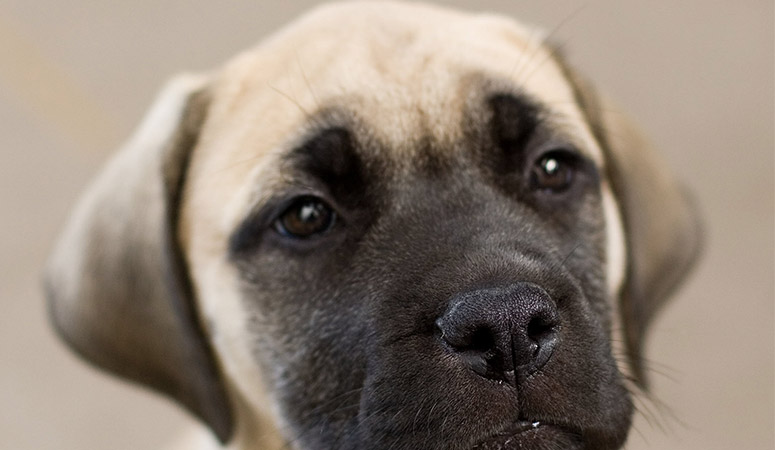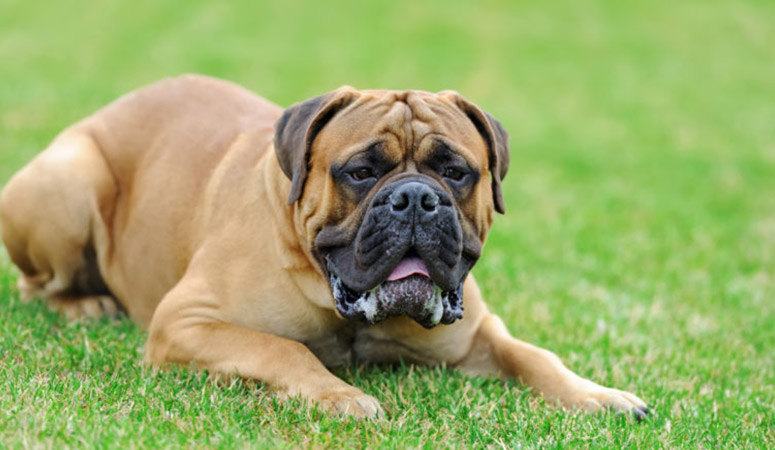Mastiff
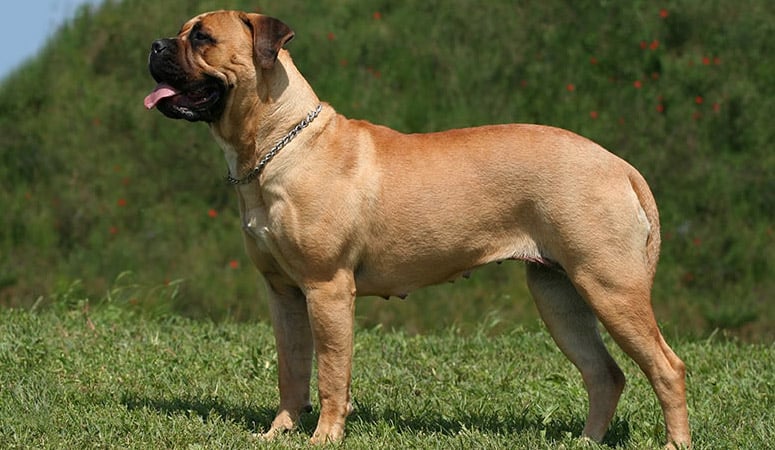
The Mastiff is one of the most ancient types of dog breeds. Mastiff is known for its huge body, massive head, short coat in a range of limited colors, and always wears an alert expression, noted for its soft and loving nature. This gentle, loyal, giant breed wants nothing more than to be near his family.
| Other Names | English Mastiff, Old English Mastiff |
| Color | Apricot, Brindle, Fawn |
| Height | Male: 27.5-30 inches. Female: 26-28 inches. |
| Weight | Males: 150-250 pounds. Females: 120-200 pounds. |
| Life Span | 6-10 years |
| Personality | Courageous, Dignified, Good-Natured |
| Exercise | Regular Exercise |
| Origin |
| Popularity | #32 |
| Groom Needs | Occasional |
| Kids Friendly | Yes |
| Dog Friendly | Yes with supervision |
| Watch Dog | |
| Family Dog | |
| Litter Size | 6-10 |
Mastiff Pictures
Mastiff Video
Introduction
When you take on a mastiff as a pet, you are getting a big dog, a good-natured and faithful companion to you and your older children. They grow to be about 31 inches at the shoulders and weigh as much as 200 pounds. They have floppy ears and droopy eyes. They are short-haired, coming in colors like apricot, brindle, and fawn. They have drooping jowls and he is a well-known drooler and snorer. They tend to be suspicious of strangers, making them protective of the family. It is important to expose the mastiff to a lot of new people as a puppy to socialize him. Couch potatoes kind of allow their Mastiffs to become couch potatoes too, but he needs plenty of nutritious healthy food and plenty of exercise. He will also eat a lot, but the higher the quality of nutrition, the less he will need to eat. People often think cheap dog food is cheaper, but it will cost more in the long run in medical bills too. With their short hair, they are easy to groom; a weekly brushing is all they require.
Living with Mastiff
The Mastiff has a short, dense coat which is easy to groom, brush your dog’s coat once a week with a rubber hound glove. And during periods of heavy shedding once or twice a year, it is recommended to brush more frequently with a strong, toothed comb to remove dead hair.
Mastiffs only need to be bathed as needed, but the owner needs to clean your dog’s wrinkles every day in order to prevent bacterial infections. It is important to clean the wrinkles and dry them thoroughly. Also, don’t forget to clean the flews (the part of the upper lip that hangs) after meals.
The owner needs to know that Mastiffs drool, keep cloths at hand to wipe “slingers” off their Mastiff’s face. Check your dog’s ears regularly for the signs of wax buildup, irritation, or infection. And clean them with a cotton ball and gentle cleanser. Brush the teeth weekly to keep fresh breathe and prevent gum disease. Trim nails monthly if the dog does not wear the toenails down naturally outdoors.
Mastiffs are house dogs, they can live happily in an apartment, and they can also adapt to country life, best in a home with a fenced yard.
Mastiffs have comparatively low exercise requirements. An adult Mastiff would be satisfied with a couple of 20-30 minute walks every day. They are not good jogging companions as their giant size. They would overheat easily and their joints can be damaged from the stress of running. Besides, walks are best in the cool mornings and evenings. The growing puppies and young adults need more care when exercise, don’t let them run up and downstairs, jump from highs, or engage in long walks.
Proper nutrition is critical through puppyhood and up to 2 years of age for the rapidly growing giant breeds such as Mastiff, slow and steady growth is optimal. The formulated dog food in an appropriate calcium/phosphorous ratio is recommended by most breed experts.
The Mastiff is prone to gastric dilatation volvulus or bloat. Generally, it is recommended to food a Mastiff with six to eight cups of high-quality dry dog food per day, divided between two to three meals. More importantly, the food amount should depend on the dog’s weight, size, age, and activity level. There should be fresh and clean water at all times.
Some dogs are easy to get overweight, so you need to watch their calorie consumption and weight level all the time. Treats may be an important aid in training, but excessive intake can lead to obesity. Also, owners need to distinguish which human food is safe for dogs and which are not. If you have any problems with your dog’s weight or diet, just consult from your veterinarian.
Mastiffs are prone to the following health conditions: gastric torsion (bloat), hip dysplasia, arthritis and joint disorders, orthopedic concerns, eye diseases, hypothyroidism, cystinuria, Seizures…
Major concerns: gastric torsion, CHD
Minor concerns: osteosarcoma, cystinuria, elbow dysplasia
Occasionally seen: cruciate ligament rupture, cardiomyopathy, entropion, allergies, vaginal hyperplasia, hypothyroidism, PRA, PPM OCD
Suggested tests:
Cardiac Exam
Elbow Evaluation
Hip Evaluation
Ophthalmologist Exam
Total Annual Cost: $3536
Cost is estimated for the first year and may vary depending on many factors, such as dog food, health care, leash, collar, licensing, possible fencing, crates, training and obedience classes, dog-walking, grooming, treats, toys, flea, tick, and heart-worm meds, microchips, etc.
Don’t run over the Mastiff for the first two years of its life, this may cause the hip and joint problems for these large dogs. Mastiff could respond well to basic obedience training, but he may be stubborn or unmotivated to learn and follow the rules. Short training sessions are better to keep the Mastiff’s attention. Early training from puppyhood like socialization with people and other dogs is necessary to encourage good behaviors.
Mastiffs are eager to please and learn quickly. But the repetitions in a typical training class will quickly bore them. The owner should make eye contact with your dog, Mastiff is good at eye contact and reading your expression and body language. Besides, patience and positive reinforcement are necessary for training your Mastiff and don’t use harsh training methods.
History
The name Mastiff usually also means the old English Mastiff. These dogs come from an ancient heritage. They were found in Britain when the Romans invaded the island; some say they might have been brought there by Phoenician traders as early as the 6th century BC already.
There is evidence that Mastiff-like dogs lived in the mountains of Asia as far back as 4,500 years to 2,500 B.C. In The British Museum, there are relics showing Mastiff-type dogs that look very similar to modern Mastiffs, hunting lions in the desert. Most dog breed historians agree that the British are responsible for creating the dog we have today.
Today, this dog is well established in England, Canada, and America. A Mastiff reportedly came to America on the Mayflower, although records are scarce. The real importation of Mastiffs into the United States however didn’t begin until the late 1800s.
When the military commander, Hannibal, crossed the Alps, there were several Mastiffs accompanying him. These dogs encountered a lot of local breeds, causing several new breeds to form, including the St. Bernard, which was once called the Alpine Mastiff.
There was a Mastiff called Zorba – he once held the record for the world’s largest dog, setting the record in November 1989, when he was eight years old. Can you believe that he was 37 inches high at the shoulder, and weighed 343 pounds!
Helpful Information
Breed Club: MASTIFF CLUB OF AMERICA, INC.
Breed Club Link: https://www.mastiff.org/
Breed Club Rescue: MCOA Rescue Foundation Incorporated (RFI)
Breed Club Rescue Link: https://www.mastiff.org/rescue/

